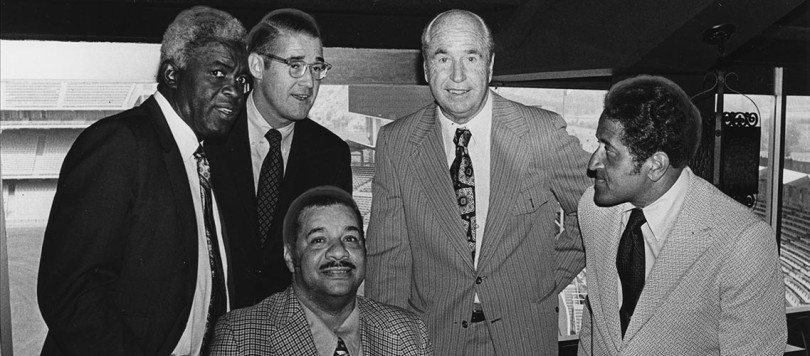
Saturday, June 3, 1972, The Stadium Club at Dodger Stadium, Los Angeles. (L-R) Front – Roy Campanella; Back – Jackie Robinson; Dodger President Peter O'Malley; Dodger Manager Walter Alston; Don Newcombe. Photo taken at Old-Timers’ Day Luncheon, the day before the uniform retirement ceremonies for Robinson (42), Campanella (39) and Sandy Koufax (32).
Los Angeles Public Library
Pursuing Progress
By Robert Schweppe
U.S. President Joe Biden greeted the 2020 World Champion Los Angeles Dodgers at the White House on July 2, 2021. In his remarks, President Biden said of the team, “The Dodgers are a lot more than a baseball club. They are a pillar of American culture and American progress.” U.S. President Joseph Biden, July 2, 2021 The President spoke of Sandy Koufax, Fernando Valenzuela, Vin Scully, and he added, “…and above all else, Jackie Robinson.” Ibid.
By his mention of Jackie Robinson, throughout the United States and the world, the Dodger organization is recognized as pioneers to the breaking of the color line in sports. Daniel Dodson, Report of the Mayor’s Committee on Baseball, October 31, 1945 Jack Lang, Jersey Journal, July 29, 1952 Rev. Gordon Hancock, St. Paul Recorder, October 16, 1953 Roger Kahn, “The Boys of Summer, 1972” In 1972, Dodger pitcher Al Downing told writer Bob Oates of the Los Angeles Times, “I’d always hoped to play for them (the Dodgers). They were the team that gave the black man a chance.” Bob Oates, Los Angeles Times, February 4, 1972 Even a Dodger nemesis, Hall of Famer Willie McCovey, wanted to play for the Dodgers before he signed a pro contract. Eric Prewitt, Associated Press, May 5, 1980
A.S. “Doc” Young, a writer for Ebony magazine wrote in the September 1963 edition, “No other area of American life comes closer than a distant second to sports in the matter of practicing democracy.” A.S. “Doc” Young, Ebony magazine, September, 1963 As the veteran writer is correct in his statement, then baseball led sports. And the Dodgers led baseball.
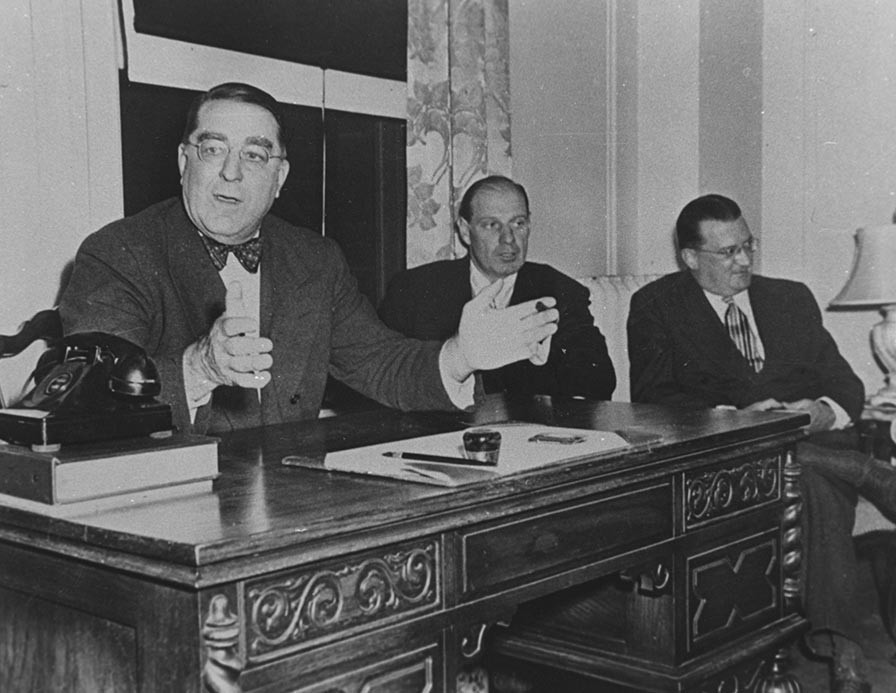
On May 6, 1946, Dodger Manager Leo Durocher (center), Dodger President Branch Rickey (left) and Club Secretary Walter O’Malley, inform press about injunction suit filed by Dodgers in St. Louis against the Mexican Baseball League.
Without the Dodgers’ efforts to improve their team, the pace of integration would certainly have been slower. In the nick of time, there were debuts and prime seasons of stars in the 1950s such as Henry Aaron, Ernie Banks, Roberto Clemente, Willie Mays, and Frank Robinson. The 1960s-decade next revealed Lou Brock, Rod Carew, Bob Gibson, Willie McCovey, Joe Morgan, and Wilver Stargell, and Billy Willaims, all of them elected to the Baseball Hall of Fame.
Dodger General Manager and partner Branch Rickey deserves accolades for his dedication to end baseball’s segregation with the signing of Robinson. Rickey himself would acknowledge the role of his partners, Walter O’Malley and John Smith, co-owners of the Dodgers in the signing of Robinson. Branch Rickey, The American Diamond, 1965 A.S. “Doc” Young, Ebony magazine, November, 1968 Dick O’Connor, The Sporting News, February 18, 1959
Were the acts of signing Black players desegregation or integration for baseball? Dr. Martin Luther King, Jr. defined the differences. In a July 1962 speech, Dr. King spoke of the “Ethical Demands of Integration.” Acts of desegregation, Dr. King explained, “removes these legal and social prohibitions.” Next, Dr. King said, “We launch now the parallel thrust of integration process.” Dr. Martin Luther King, Jr. “Ethical Demands for Integration”, July 27, 1962 He described integration as “Creative…more profound and far-reaching…Integration is the positive acceptance of desegregation and the welcomed participation of Negroes into the total range of human activities…Integration is the ultimate goal of our national community.” Ibid.
A.S. “Doc” Young of Ebony magazine wrote in 1969, “The achievements of Jackie Robinson’s followers were significant of course; but they were never as quite as newsworthy in this context as his own simply because the barriers had now been broken, and that was the big job…but, time marched, and (integration) progress was made with each new entry and every little bit helped make a better ‘world’ somewhere, somehow.” A.S. “Doc” Young, Ebony magazine, April, 1969
Each welcomed participation and new entry and every little bit by the Dodgers to integrate were many and varied. They had to be because passive resistance to American civil rights would soon become very active resistance in the 1950s by the making of segregated laws Dan Shaughnessy, “Spring Training: Baseball’s Early Season,” 2003 , politicians’ words to exclude others, and private violence.
The actual first steps to change baseball’s color line occurs when Rickey and Walter O’Malley made a strong effort to sign Cuban player of African descent Silvio Garcia in 1943 for the Dodgers. Walter O’Malley, Appointment Book, March 15-April 10, 1943 Charles Maher, Los Angeles Times, May 2, 1972 Braven Dyer, Los Angeles Times, April 14, 1958 The scouting mission fell through when Garcia was not available to play because of Cuban military service.
Next, Rickey’s 1943 written report to the Brooklyn Dodger Board of Directors underscored the club effort when the Dodger President wrote (the Dodgers) to have a “scouting enterprise…a pioneer movement more thorough and more extensive than has been taken by any baseball organization.” Branch Rickey, Report to the Brooklyn Dodgers Board of Directors, May 20, 1943 The “pioneer movement” alluded to was going to be signing many players formerly prohibited from playing Organized Baseball.
More than one Black player was going to be signed to help the club. Chris Lamb, “Conspiracy of Silence,” 2012 Pathfinder Rickey showed his determination in the signing of seven of the first nine Black players to minor league contracts. Merl Kleinknecht, 1983 Baseball Research Journal After Robinson signed, a 1945 report by prominent sociologist Dan Dodson that “the move by the Brooklyn club…paves the way for others to follow.” Dan Dodson, Report of the Mayor’s Committee on Baseball, October 31, 1945 And eventually teams would sign black players, albeit on a far slower pace than the Dodgers. Andrew O’Toole, “The Best Man Plays: Major League Baseball and the Black Athlete”, 2003
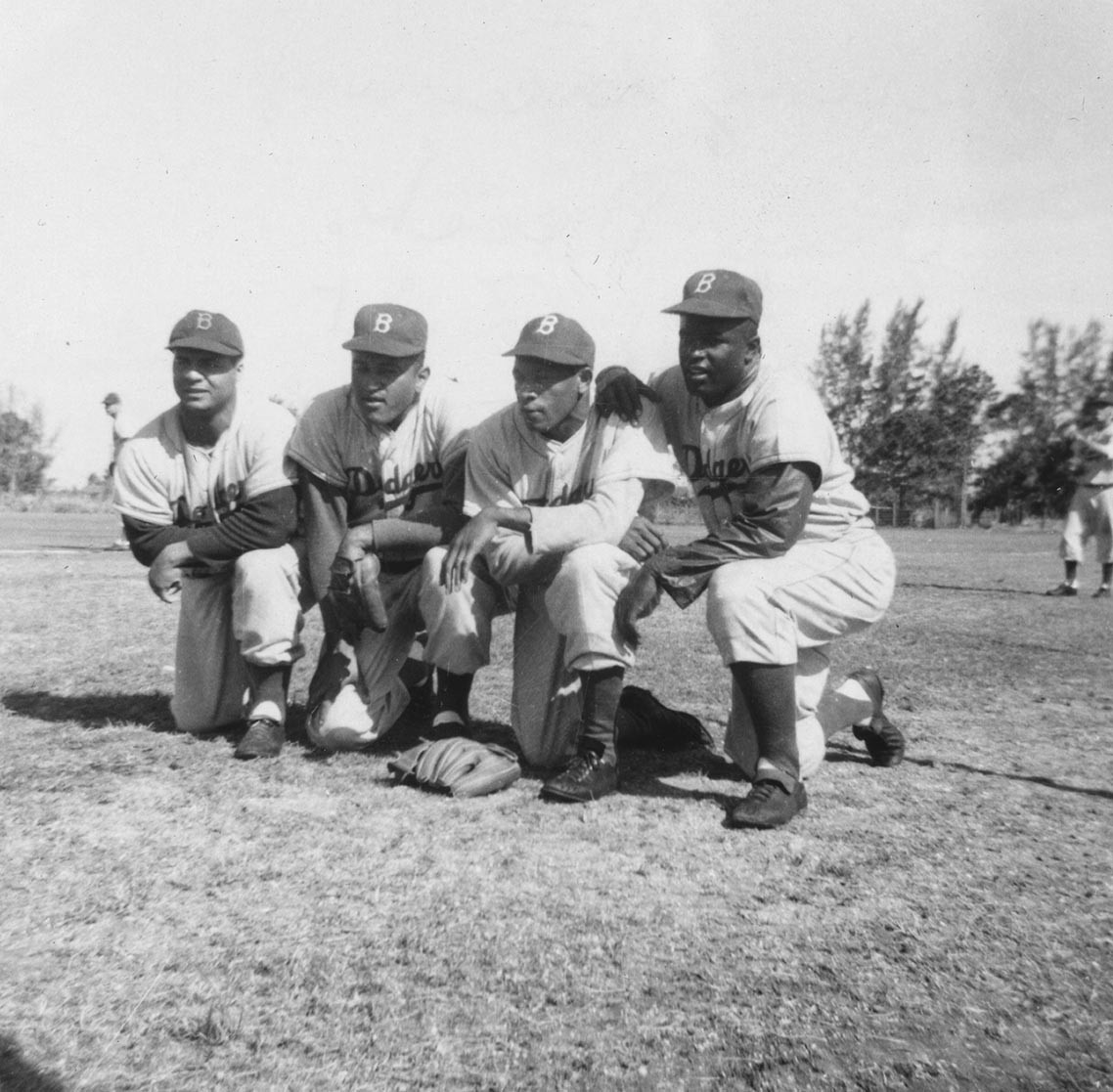
In March, 1950 at Dodgertown, Vero Beach, Florida, (L-R) catcher Roy Campanella; pitcher Don Newcombe; pitcher Dan Bankhead; and infielder Jackie Robinson. Dodgertown was Major League Baseball’s first fully-integrated spring training site in the South. All players stayed, dined, and played together on base.
Photo by Peter O’Malley. All Rights Reserved.
The signing of American Black players had an unintended multiplier effect. Latin players of African descent would be scouted, signed, and developed. Samuel Regalado wrote, “Dominican Felipe Alou was only twelve years old when, in 1948, the Dodgers paid a visit to his homeland. Excited about the prospects of seeing big leaguers in action, Alou’s young eyes focused on the team’s star second baseman. “It was a proud moment. To see (Jackie) Robinson in the Brooklyn lineup gave us hope. (T)here was a black man out there with a major league uniform on.” Regalado added, “Yet, the long shadow of baseball’s ‘great experiment’ also reached into Latin America, where Robinson’s stature was of great importance to generations of Latin. Until 1947, Latin baseball players made up only a tiny percentage of those who competed as big leaguers…Baseball’s integration period marked an important turning point in the fortunes of Latin players. Latinos became a fixture in the big leagues, and their success spawned expanded avenues by which baseball pursued the recruitment of talent.” Samuel Regalado, “Jackie Robinson and the Emancipation of Latin Baseball Players,” 2015
Not all baseball teams were pleased with the Robinson signing. Then Baseball Commissioner Albert “Happy” Chandler admitted years later club owners disapproved of the potential promotion of Robinson to the major leagues in a vote of 15 to 1. Cindy Rugely, Lexington Herald-Leader, July 13, 1986 Larry Eldridge, Christian Science Monitor, August 2, 1982 The only vote in favor of Robinson playing in the big leagues was cast by Rickey, O’Malley, and John Smith, co-owners of the Dodgers, who equally controlled 75 percent of the stock. Marie “Dearie” Mulvey was the other 25 percent stockholder.
From their first seasons, Robinson and pitcher Dan Bankhead (1947), Campanella (1948), and Newcombe (1949), the Dodgers maintained a firm belief in their integration stance. In the 1946 spring training season, the Montreal Royals, the Dodgers’ AAA entry in the International league and Robinson’s first team, refused to play exhibition games in cities that would not permit teams of White and Black players to play in the same game. Montreal Gazette, April 6, 1946
Several baseball Minor leagues were integrated by the Dodgers. They included the International League (Robinson, John Wright) in 1946, the New England League (Campanella and Don Newcombe) in 1946; the Canadian American League in 1947 (Sammy Gee); and the American Association in 1948 (Roy Campanella). And, the organization was careful not to assign players to minor league cities where resistance to integration would increase the already visible pressure for the player.
The date of April 15,1947 begins baseball’s greatest era where all players now have a chance to play in the big leagues. Jackie Robinson is in the starting lineup on Opening Day at Ebbets Field in Brooklyn and Leo Durocher’s prediction to Dodger players that “From everything I hear, he’s only the first! Only the first! There’s many more coming behind him and they have the talent and they’re gonna come to play!” Jeff Marlett, Society for American Baseball Research The Dodgers were going to find the best players wherever they were. If players did not want to play further for the club, they would be assigned elsewhere. If they faced the loss of signing amateur players in the South because of their integration, they would not be deterred. New York Times, October 23, 1945
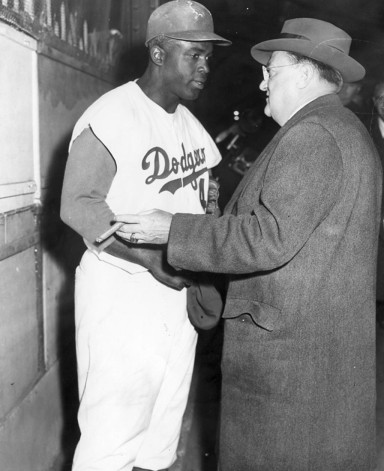
On October 9 after Game 6 of the 1956 World Series, Dodger President Walter O’Malley congratulates Jackie Robinson on his game-winning hit in the 10th inning to defeat the New York Yankees, 1-0. Robinson’s last official major league hit as a Dodger won a World Series game.
Robinson’s play and dedication inspired future Hall of Fame players such as Henry Aaron Larry Crowe, “The History Makers”: History Makers Digital Archives, October 1, 2016 and Frank Robinson. Through Jackie’s courageous play, Aaron and Robinson believed for the first time they had a chance to play in the majors. Larry Whiteside, Boston Globe, August 2, 1982 TIME Magazine, 2007 Larry Whiteside, Boston Globe, August 2, 1982 Jackie would finish fifth in the 1947 National League Most Valuable Player voting. It is the first time in baseball history a Black player would receive votes for MVP since the award began in 1911.
The impact of the Dodgers’ integration went further than baseball. Archbishop Desmond Tutu, 1984 Nobel Peace Prize honoree, wrote of Jackie Robinson’s impact upon his own life in a November 1995 edition of Ebony magazine. Tutu wrote in the feature, “My First Ebony” that “It was the issue describing how Jackie Robinson broke into Major League Baseball…what was important for me, I still recall, is how I shot up in stature because although I didn’t know what baseball was, what was significant for me was that here was a Black guy, admittedly several thousand miles away, but he was Black and even in that stage in my life I knew that we had a commonality and solidarity…” Bishop Desmond Tutu, Ebony, November, 1995
The 1948 season would have the Dodger majority tri-owners, Rickey, O’Malley, and Smith, along with stockholder Mulvey, open Dodgertown in Vero Beach, Florida, as Baseball’s first and only planned integrated spring training camp in the South. Michael Beschloss, “When Jim Crow Got Cut From Spring Training,” New York Times, February 14, 2015 A Dodger player told the Baltimore Afro-American newspaper that first spring, “The only segregation in Dodgertown existed by ability, not color.” Baltimore Afro-American, April 10, 1948 Other baseball teams would not integrate their spring training camp in Florida until 1962 and not until significant, national and player pressure were put on teams. Sam Lacy, Baltimore Afro-American, March 4, 1961 Jack Davis, Baseball’s Reluctant Challenge: Desegregating Major League Baseball Sites, 1961-1964” Journal of Sports History, 1992
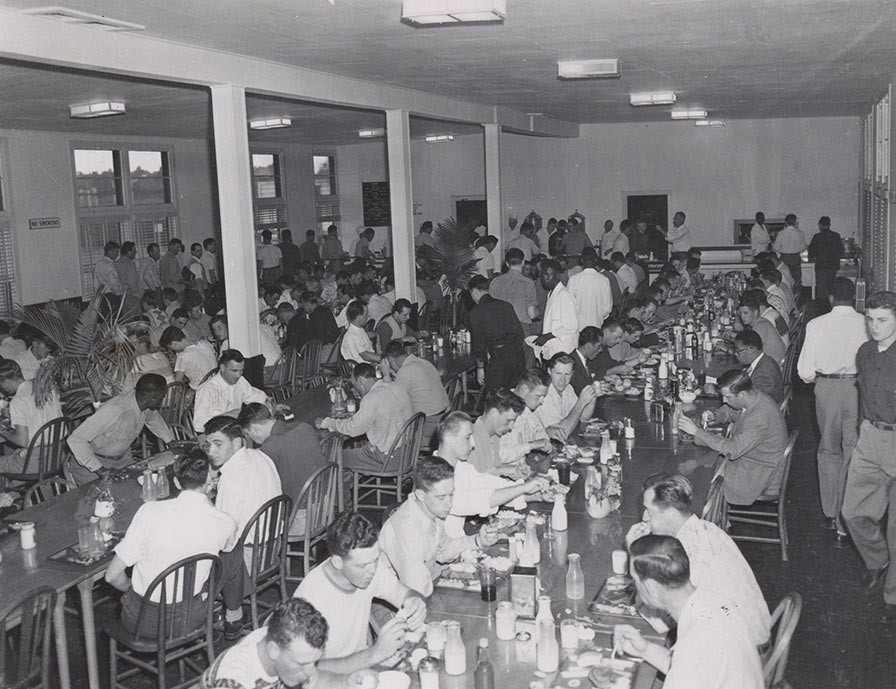
The Dodgertown dining room with a buffet line for breakfast, lunch, and dinner. Dodgertown was notable for being the only integrated Spring Training quarters in the South when it first opened in 1948, meaning all players, regardless of color of skin or national origin, would eat together.
Dodgertown is the only Florida spring training base where all players of color lived under the same roof and ate in the same dining room. Jerald Podair, “Haven of Tolerance,” walteromalley.com, February 25, 2015 Roger Kahn, Black Sports, June, 1953 Sam Lacy of the Baltimore Afro American wrote, “It (integration of Dodgertown) was the first crack in the wall of prejudice that continued to plague baseball for the next 15 years.” Sam Lacy, Baltimore Afro-American, April 23, 1974 In 2014, the state of Florida would commemorate a historical marker to recognize Dodgertown as a noted place of integration. Jessica Cragan, Hometown News, November 10, 2014 In 2019, the U.S. Civil Rights Trail honored Dodgertown as a location stating, “These progressive actions that began with a baseball team went beyond Dodgertown and Vero Beach, influencing social change nationwide.” U.S. Civil Rights Trail, uscivilrights.com Brad Pye, Jr. wrote in the Los Angeles Sentinel, that “In retrospect, a move which was originally made so that Black ballplayers could eat, practice and live with their teammates without any racial strife, has benefitted all the players who train here. It has also made the Dodgers the envy of the other pro sports teams.” Brad Pye, Jr., Los Angeles Sentinel, March 20, 1980
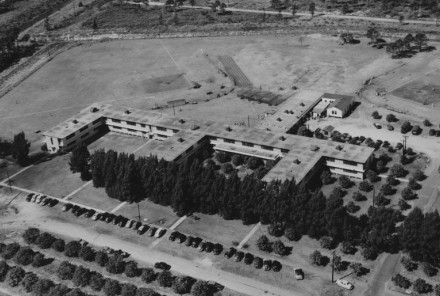
An aerial view of Dodgertown, Vero Beach, Florida circa 1950 with the former U.S. Naval Air Station barracks for living quarters, Field No. 1 to the left, and Field No. 2 to the right.
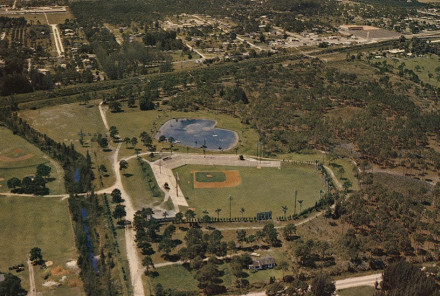
A 1959 postcard view of the heart-shaped lake and Holman Stadium in Dodgertown, Vero Beach, Florida.
Dodger ownership was clear in their goal of integration for the team. O’Malley wrote a 1948 internal memo to Arthur Mann, Rickey’s assistant, “I think, we all agree, that as a corporation, our interest is in superior baseball players, and not in their color or religion.” Correspondence, Walter O’Malley to Arthur Mann, May 2, 1948
The Dodgers integrated states. Their 1948 game in Fort Worth, Texas is the first time in Texas mixed teams played in a baseball game when the Dodgers played their farm team there. St. Paul Recorder, April 9, 1948 The next season, the Brooklyn Dodgers, scheduled three exhibition games in the heart of the South, Atlanta, Georgia, where no integrated teams had ever played. Rickey said, “Nobody can tell me what players I can or cannot play.” He promised the New York Times the Dodgers would not play if they could not field their entire team…“And that is all there is to that.” New York Times, January 14, 1949 The economic pressure by the Dodgers not to play caused city officials to back down, drawing the largest crowds in Atlanta baseball history. New York Times, April 10, 1949 Bruce Adelson, “Brushing Back Jim Crow,” 1999 Stephen Tuck, “Beyond Atlanta: The Struggle for Racial Equality in Georgia,” 2003
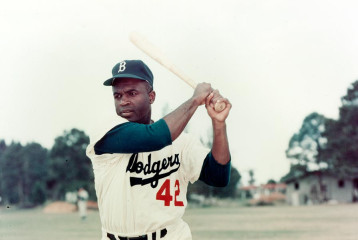
In the mid-1950s, Jackie Robinson, No. 42 at Dodgertown, Vero Beach, Florida. In 1948, when Robinson played at Dodgertown, the site became MLB’s first fully-integrated Spring Training camp in the South in the United States. In 2019, MLB assumed business operations at Historic Dodgertown and renamed it the Jackie Robinson Training Complex.
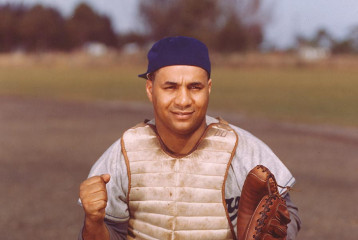
Hall of Famer Roy Campanella was a three-time National League MVP during his years with the Dodgers, 1948 to 1957. The pioneer catcher was beloved by his teammates and fans.
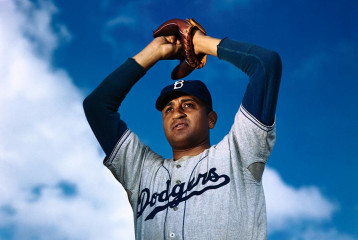
Dodger star pitcher Don Newcombe, circa 1950’s, was the first player in major league history to win the Rookie of the Year (1949), the Cy Young Award, and Most Valuable Player (1956). He was the first African-American pitcher to start a World Series game when he was named for Game 1 in the 1949 World Series.
On May 20, 1949, the Dodger players, Robinson, Campanella, and Newcombe, made baseball history by having three Black players in the starting lineup. National acceptance recognition for Robinson and his ability came when American baseball fans elected him by a vote as the starting second baseman for the National League in the 1949 All-Star Game.
The Baseball Writers’ Association selected Robinson as the 1949 NL Most Valuable Player. From 1911, the first year of the league MVP, to 1948, no Black player had ever received the award. From 1949 to 1962, the NL MVP would go to a Black player 11 times. A total of 24 different Black players in the two leagues would finish in the top five of MVP voting 35 times. It should be regarded as the greatest boost in player talent any sport has ever enjoyed.
As a new decade opened to the 1950s, the Dodgers continued to break new ground for Black players. Jackie Robinson’s 1950 player salary made him the highest paid Dodger after only his third major league season. United Press, January 24, 1950 He would remain the team’s highest paid player until replaced by Campanella in 1956.
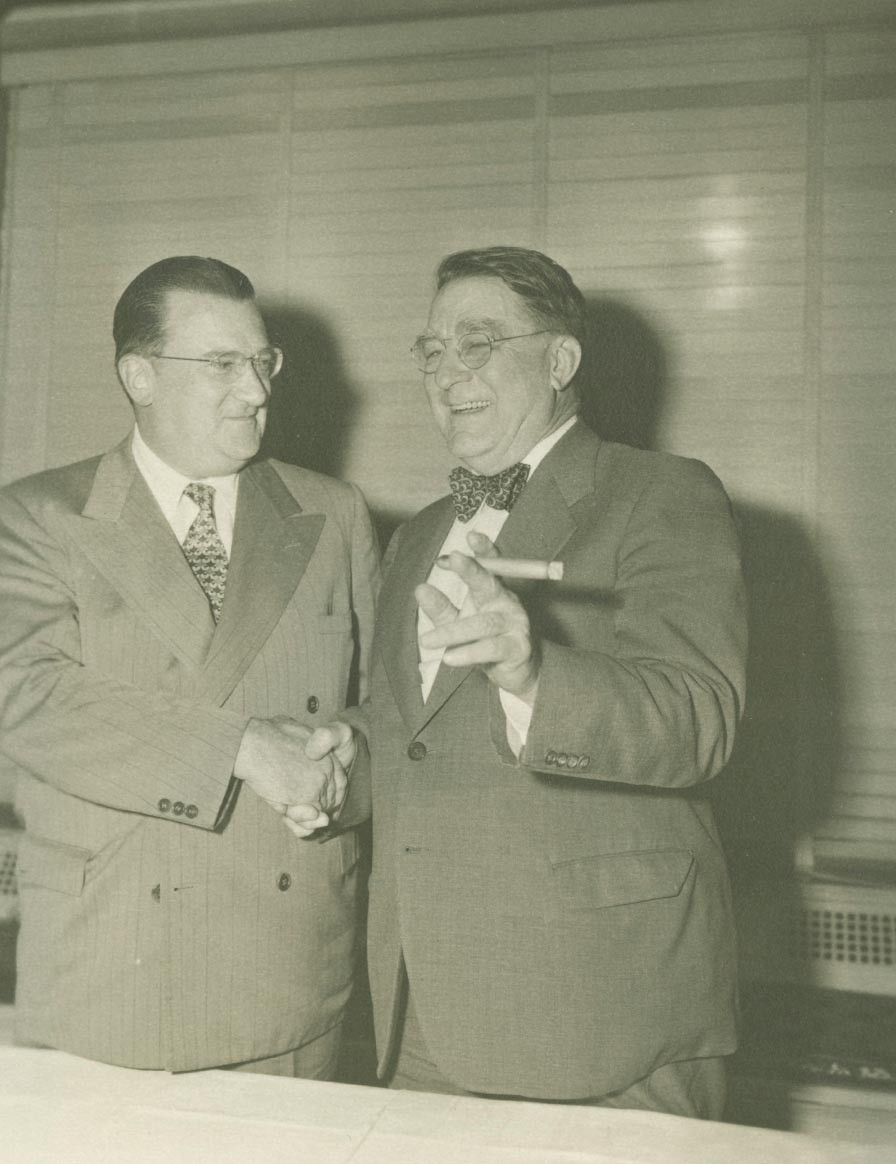
Branch Rickey (right) congratulates Walter O’Malley after O’Malley was named President of the Brooklyn Dodgers on October 26, 1950. O’Malley held a press conference in Room 40 of the Hotel Bossert, Brooklyn. Rickey sold his one-quarter stock interest in the Dodgers to O’Malley and Mrs. John L. Smith and O’Malley became controlling owner.
Photo by Barney Stein
At the end of the 1950 season, Rickey sold his Dodger stock shares to O’Malley and O’Malley became the majority owner of the Dodgers. As to whether or not the Dodger player integration efforts were diminished, Ebony magazine in May, 1953 stated of the Dodgers, “Has continued where Rickey left off.” Ebony magazine, May, 1953 Robinson in his 1964 book, “Baseball Has Done It,” wrote that “the change in (Dodger) ownership…made little if any difference in the club’s overall attitude toward Negroes.” Jackie Robinson, Baseball Has Done It, 1964
A.S. “Doc” Young would write in 1957, “Since (Walter) O’Malley became top dog in Dodgerdom, integration in this organization has maintained (Branch) Rickey’s pace, if not quickened it. You can prove that by the daily lineups.” A.S. “Doc” Young, Los Angeles Sentinel, June 6, 1957 One of O’Malley’s earliest statements upon being named President of the Dodgers was “Prejudices have no place in our society and certainly not in sports.” “The Old Scout, Grit newspaper, October 30, 1950 O’Malley refused to use a railroad for any type of business when it was learned a racist (railroad) employee struck a Black Dodger minor leaguer. Walter O’Malley, Correspondence to Harold Parrott, May 2, 1951
The Dodgers didn’t stop with player integration. They wanted the best person for integration for baseball managers. In the 1951 spring training at Dodgertown, the new Dodger President offered Jackie Robinson a chance to manage the Dodgers’ AAA team after his playing days were over. Larry O’Brien, Montreal Standard, March 24, 1951 O’Malley would make an offer to Roy Campanella to coach and manage in the Dodger organization once his career ended. Baltimore Afro American, October 14, 1952
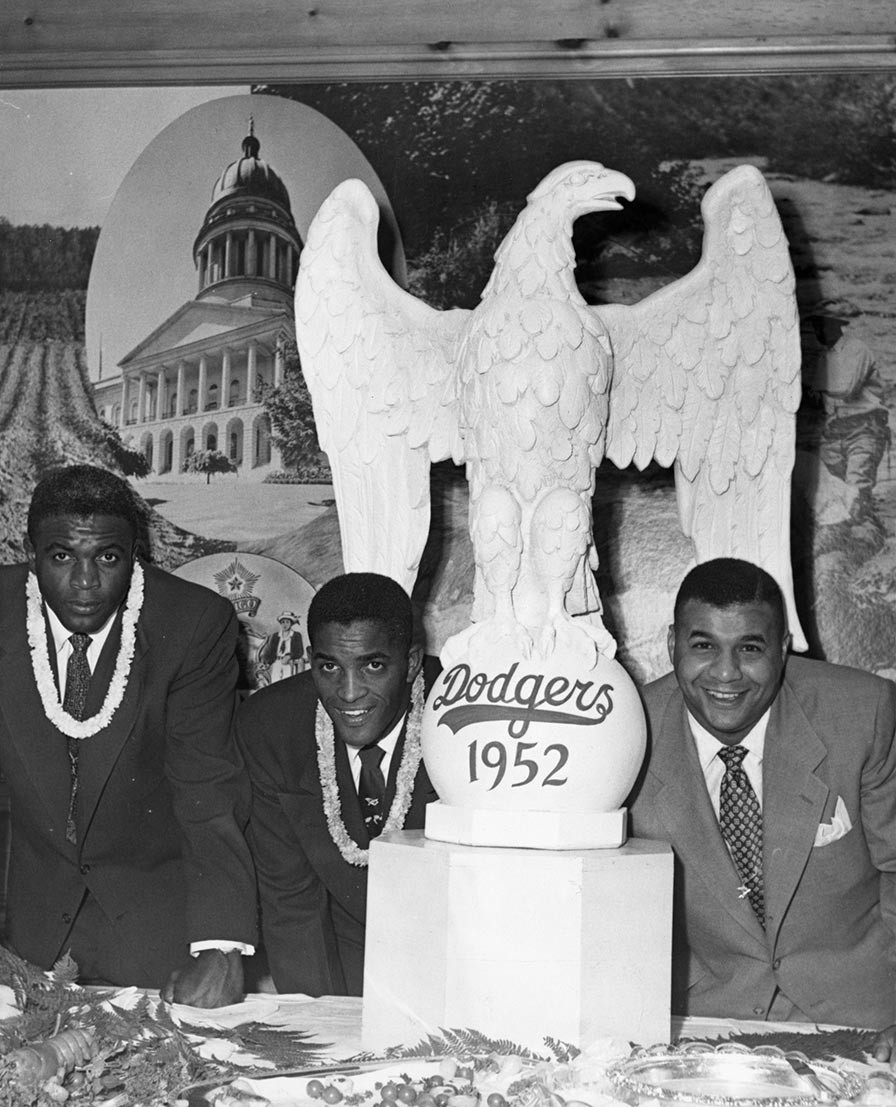
Roy Campanella (far right) celebrating with teammates Jackie Robinson (left) and Joe Black at the Brooklyn Dodgers’ 1952 National League Pennant victory party at the Hotel Bossert.
The 1952 spring training season saw Joe Black make the Dodgers as a non-roster pitcher. He would pitch so well he was elected the 1952 NL Rookie of the Year. The Dodgers expanded their broadcasting network with games re-created by Nate Allbright so fans from the Washington D.C. to Florida could stay up to speed with their favorite Dodger players. Jules Tygiel, “Past Time: Baseball As History,” 2000
Regrettably, there were still fans who objected to integration. The Dodger President responded to an unreasonable fan toward the Dodger use of Black players. O’Malley’s response was crisp and to the point. “We will put the best team on the field that we can in spite of anyone’s prejudice as we have no prejudice in this organization. Our sole ambition is to win ball games for the Brooklyn fans.” Walter O’Malley, Correspondence, March 25, 1953 O’Malley responded to another party, “I was sorry to note from your letter that you object to Negro ball players. I am afraid the spirit of intolerance is still with some people, but I know that I cannot subscribe to such feelings.” Walter O’Malley, Correspondence, June 4, 1953
The 1953 season was the first time in Dodger history the team won consecutive National League pennants. The Dodgers held a night where the National Advancement Association for Colored People had a fund raiser before a game at Ebbets Field and Roy Campanella spoke at the pre-game ceremony. Juluis Adams, St. Louis Argus, September 12, 1953
The Dodgers did more than most clubs to scout talent. They led the industry in “coconut-snatching,” where a player is converted from his original position when he signed to another position on the field. Maury Wills was signed as a pitcher in 1951 and converted to infielder and later to shortstop. They helped him to become a switch-hitter. The Dodgers showed their patience in retaining Wills in their system until he made his debut in 1959. John Roseboro signed as an outfielder and changed to full time catcher. Both men played for three Dodger World Championship teams in 1959, 1963, and 1965 and were regular All-Stars.
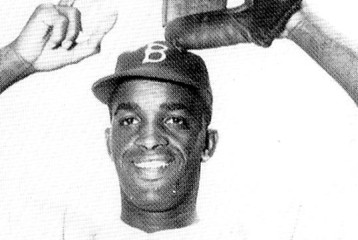
Dodger pitcher Joe Black was voted the 1952 National League Rookie of the Year and was the first African-American pitcher to start and win a World Series game.
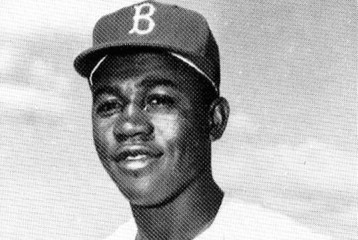
Dodger infielder Jim Gilliam (1953-1966) and Dodger coach (1965-1978). Only Gilliam, Johnny Podres, and Sandy Koufax played on four Dodger World Championship teams (1955, 1959, 1963, and 1965). Gilliam made a game-saving play in the seventh game of the 1965 World Series. Upon his sudden passing in 1978, his uniform number 19 was retired by the Dodgers.
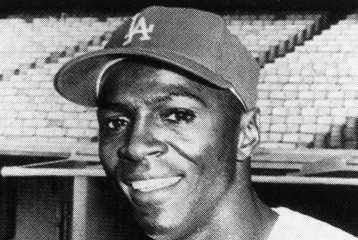
“Sweet” Lou Johnson was the sparkplug that carried the Dodgers to their 1965 World Championship title. Recalled from Spokane in the Pacific Coast League in May, Johnson was an immediate contributor providing power to a team that lacked it as his 12 home runs tied him for the club lead. He scored the only run in Sandy Koufax’s 1965 perfect game. Johnson hit two home runs in the 1965 World Series for the Dodgers, including a solo home run in Game 7 to give Koufax all the runs he needed in his shutout for the Dodgers’ World Championship.
On July 17, 1954, the Dodger starting lineup made baseball history. As the Dodgers defeated the Milwaukee Braves, 2-1, they started five Black players in their lineup. Sandy Amoros played left field, Roy Campanella was the catcher, Jim Gilliam at second base; Don Newcombe, the starting pitcher, and Jackie Robinson played second base. Contrast that moment to when it is realized when the 1954 season started there were still four teams without one Black player. From 1954-1956, the Dodgers started five players in the lineup and won 25 of 30 games, an .833 winning percentage.
The Dodgers were aware of the use of economic pressure to integrate for the benefit of all their players. The city of Birmingham, Alabama changed a law that had banned players of mixed race to allow a Dodger exhibition game to be played there. Baltimore Afro-American, February 2, 1954 The Dodgers then refused to play a game in the same Birmingham after the city reinstated a segregation ordinance of refusing mixed teams to play. New York Times, February 14, 1956 The team told a St. Louis hotel that all players had to stay there when the Dodgers traveled on the road or they would stay elsewhere. The hotel gave in to the demand. Jackie Robinson, LOOK magazine, February 8, 1955 At the end of the 1956 season, the Dodgers announced they would no longer play exhibition games in the South outside of the state of Florida. Roscoe McGowan, New York Times, December 26, 1956 The Dodgers sent their spring training players into Vero Beach with money to spend in town showing the economic engine of the team. Mark Langill, “Dodgertown,” 2004
Jackie Robinson acknowledged the racist tenor of the 1950s and the slow walk to integration, but there was a long-term goal in mind. Robinson said, “Anything done overnight is dangerous. But if you do it slowly, seeing all along what is happening, that is the type of foundation that lasts…There should be a goal which would make 1956 better than 1954, and 1958 better than 1956. Then, maybe by 1960, schools could be integrated.” Jackie Robinson, Los Angeles Times, February 16, 1954
In a 1955 LOOK magazine article, Robinson conveyed his appreciation to Walter O’Malley and the Dodgers for their stance never to limit Black players on the squad. Robinson wrote, “Mr. O’Malley told me that he wouldn’t hesitate to put nine Negroes on the field if they were the nine best available players…That was enough to convince me that the Brooklyn management wanted to win — period.” Jackie Robinson, LOOK magazine, February 8, 1955
On January 23, 1955, Robinson hand wrote a letter to Walter O’Malley expressing his appreciation to O’Malley for the Dodgers’ $500 contribution to the Piney Woods Country Life School, a Black boarding school in Mississippi. Robinson became aware of the outsized contribution and wrote in his letter, “In my nine years in the organization I have been very proud of the job we all have done in promoting better understanding and have felt this pride in my many talks across the country. What you did increases my feeling for the organization and my respect for you, which I admit has waned some in the last few years.” Jackie Robinson letter to Walter O’Malley, January 23, 1955
Through the 1955 season, Robinson remained the Dodgers’ highest paid player and for a time, the highest paid in team history. American Negro Press, Los Angeles Sentinel, January 27, 1955 Dink Carroll, Montreal Gazette, July 28, 1962 One year after Brown v. Board of Education (1954) the “separate but equal” law was ruled by the Supreme Court as unconstitutional, Robinson would speak to St. Louis elementary school students, and praised baseball as “smoothing the path of segregation in public schools.” St. Louis Globe-Democrat, September 15, 1955
On April 17, 1956, for the first time in baseball history, the Dodgers started five Black players on Opening Day. A sixth Black player, Sandy Amoros, played in the game as a pinch-hitter.
In his final playing season in 1956, Robinson assisted in the signing of a new generation of players. Tommy Davis, a future NL batting champion, played for Boys High School in New York City and was approached by the Dodgers and the New York Yankees to sign. Davis’ mother was concerned the Dodgers had a quota of Black players and Tommy wouldn’t receive a fair shot. Robinson called Davis personally and would also tell sportswriter Wendell Smith, “This is one thing a ten-year man can GUARANTEE…For anyone to suggest that the Dodgers are not interested only in good ballplayers — regardless to race — is to give them a bum rap. But I am convinced that this organization is interested only in giving Brooklyn a championship. This club wants pennants, and it has no quarrel with the color of a man’s skin if he can help win them.” Sam Lacy, Baltimore Afro-American, July 3, 1956 Robinson added, “His best opportunity lay with the Dodgers.” Sam Lacy, Baltimore Afro-American, March 29, 1960 Davis would go to win two NL batting titles and play for Dodger World Championship teams in 1963 and 1965.
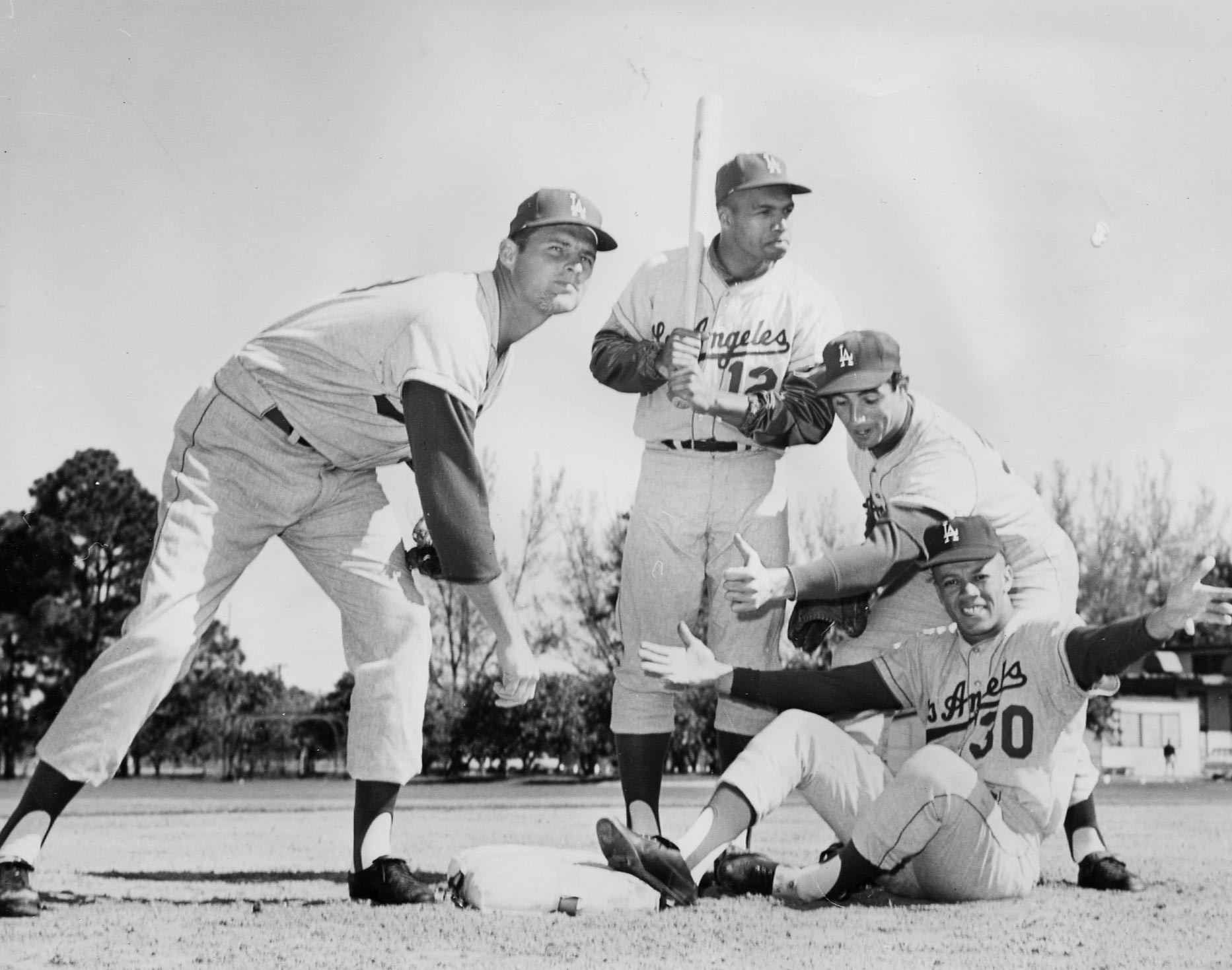
(L-R) Don Drysdale; Tommy Davis; Sandy Koufax; Maury Wills. These four Dodgers were performance leaders for the Dodgers’ great play from 1959 to 1965 where they won three World Championships in 1959, 1963, and 1965. In 1962, Drysdale won the Cy Young Award, Tommy Davis was the National League batting champion, and Maury Wills won the 1962 National League Most Valuable Player Award. In 1963, these four players were part of the 1963 World Champion Dodger team that swept the New York Yankees in four games. In 2005, Tommy Davis stated in an autobiographical book, “Tales from the Dodger Dugout,” that he signed a professional contract with the Dodgers because Jackie Robinson called Davis and gave him his strongest recommendation the Dodgers would be the best team for Davis to play.
Jackie Robinson ended his 10-year career with the Brooklyn Dodgers. His last hit in baseball drove in the game winning run in the sixth game of the 1956 World Series. He homered in his penultimate game and singled home the tie breaking run in the final game of the month-long 1956 Dodgers Goodwill Tour to Japan. After he retired from baseball, he told Mike Gaven of The Sporting News, “Mr. (Walter) O’Malley and I had our differences also, but we parted friends after a fine time with our families in Japan.” Mike Gaven, The Sporting News, January 23, 1957
Dr. Martin Luther King attended a game at Ebbets Field in 1957. He had been invited to speak at a Billy Graham rally in Brooklyn and attended “Protestant Brotherhood Day” at Ebbets Field. He autographed a ticket to a fan and that ticket was sold by the Lelands Auction house in 2023. Lelands.com, 2023
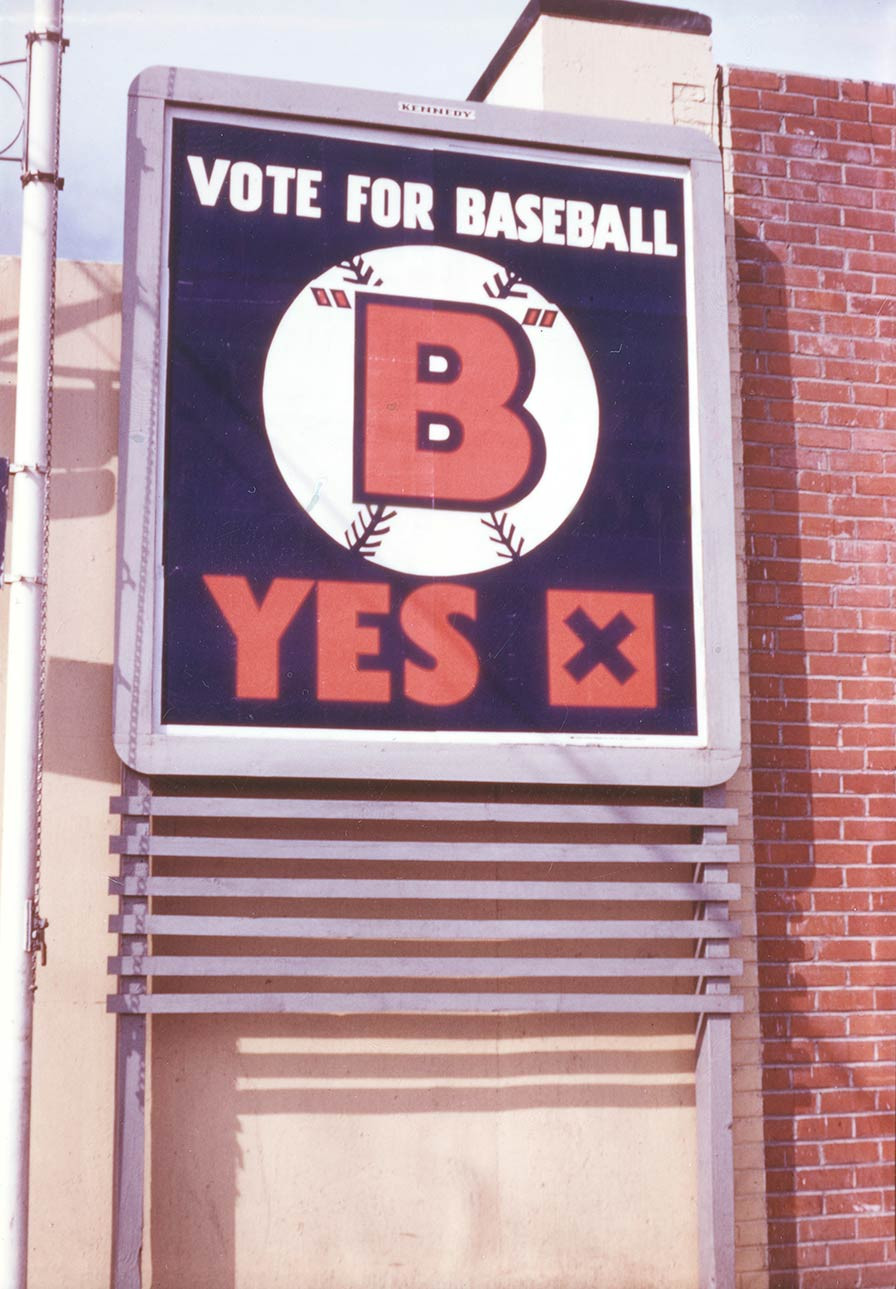
A billboard in Los Angeles for Proposition “B” to support the contract between the City of Los Angeles and the Los Angeles Dodgers. The contract provided for a mutual exchange of land and the payment of real property taxes by the team, an obligation that exists today. The land the Dodgers acquired became utilized for Dodger Stadium.
The re-location to Los Angeles by the Dodgers in 1958 made baseball a truly national game and their leadership in integration expanded. A local columnist praised Dodger broadcasters Vin Scully and Jerry Doggett for their work to be fair to all players. Brock Brockenbury, Los Angeles Sentinel, August 7, 1958 Brock Brockenbury, Los Angeles Sentinel, July 19, 1962 The Dodgers broadcast their games on the Dodgers’ Spanish radio station KWKW in Los Angeles. In 1959, KWKW became the first Spanish radio station to broadcast the World Series nationally. Los Angeles Times, October 1, 1959 The Dodgers signed Earl Robinson from the University of California for the largest signing bonus at that time for a Black player. Bob Hunter, Los Angeles Examiner, March 19, 1958 Jackie Robinson again helped his former club by his personal support to Earl Robinson to sign with the Dodgers. Ibid.
And it was Jackie who provided a video message in support of Proposition B in 1958 to Los Angeles voters. A “Yes on Prop B” vote validated the city’s contract on the exchange of land with the Dodgers where Dodger Stadium would be built. Dodgerthon, KTTV, June 1, 1958 O’Malley told A.S. “Doc” Young of Ebony magazine, “When the Dodgers moved to Los Angeles and were faced with a referendum and other problems, the black leaders in the community were quick to support the Dodgers’ position, for which we have been ever grateful. In my opinion, we would have lost the referendum without their support.” A.S. “Doc” Young, Ebony magazine, January 1971
Roy Campanella had to end his playing career because of injuries suffered in a 1958 auto accident. Dodgertown honored him with the sign, “Campy’s Bullpen” at the place just outside the base kitchen where Campy would greet others and swap stories with passer byes. Dick Young, New York Daily News, March 2, 1958 The team hired him as a scout and instructor. Los Angeles Sentinel, January 8, 1959 The next acclaim for the catcher was the Campanella tribute game on May 7, 1959, which at time, drew a baseball record crowd of 93,103 at the Los Angeles Memorial Coliseum. A plaque at the Memorial Coliseum commemorates the tribute. Hall of Fame player Ty Cobb congratulated O’Malley and the Dodgers for their support of Campanella. Ty Cobb, Correspondence to Walter O’Malley, May 8, 1959 The Pittsburgh Courier stated, “National League President Warren Giles called Campanella Night ‘the most remarkable thing in the history of baseball.’” Pittsburgh Courier, May 16, 1959
The 1959 season was capped by a thrilling pennant race, a NL pennant and a World Championship. For the first time in baseball history, four Black players were on the field for the final out of the World Series. Game 6 ended with a 9-3 win over the Chicago White Sox when Jim Gilliam, Charlie Neal, John Roseboro, and Maury Wills, all signed and developed by the Dodgers, were on the diamond.

Mrs. Mallie Robinson, the mother of Hall of Fame Dodger infielder Jackie Robinson, presents Walter O’Malley with the George Washington Carver Supreme Award of Merit for “contributions to sports, better race relations and human welfare” in 1959. University of Southern California President Rufus Von KleinSmid is in the middle.
Copyright © Los Angeles Dodgers, Inc.
Los Angeles Sentinel columnist Brock Brockenbury paid the 1959 World Champion Dodgers his compliments. “Down in the dark recesses of my heart there will always be a place for the Dodgers because they were the team which first opened the door for Negroes to enter the big time…the Dodgers have continued a policy of no discrimination, at least on the ball field. It seems safe to say that the Dodgers on the field approach more nearly what Negroes want as their share in this great democracy.” Brock Brockenbury, Los Angeles Sentinel, October 1, 1959
Walter O’Malley was the 1959 recipient of the George Washington Carver Award, Los Angeles Sentinel, November 3, 1959 an honor presented to Jackie Robinson in 1950, for “outstanding contribution to betterment of race relations.” New York Age, January 13, 1951 Mrs. Mallie Robinson, mother of Jackie, wrote in correspondence to Los Angeles Mayor Norris Poulson that “Mr. (Walter) O’Malley, as owner of the Dodgers, gave my son, Jackie, a chance to break the color line in baseball.” Mallie Robinson Correspondence, November 1, 1959
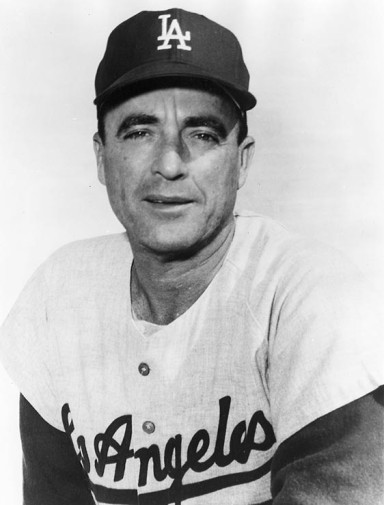
Preston Gomez was a Dodger coach from 1965-68 and 1977-79. He also managed three major league teams.
In the new decade of the 1960s, the Dodgers would again lead the way. They hired Cuban national Preston Gomez as the manager of their 1960 AAA Pacific Coast League team in Spokane, the first time in PCL history to have a diverse manager. A local columnist praised the Dodgers for the leadership of Walter Alston and his desire to win by starting five Black players without hesitation. Brock Brockenbury, Los Angeles Sentinel, April 28, 1960
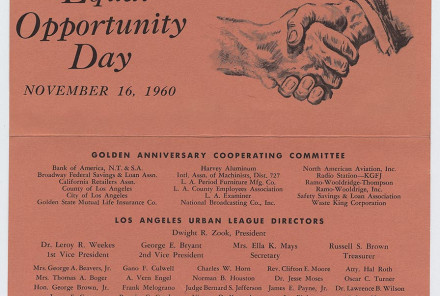
Program for the Los Angeles Urban League on November 16, 1960 in observance of Equal Opportunity Day. Dodger President Walter O’Malley is the guest speaker to 1,000 guests at the Statler Hilton Hotel.
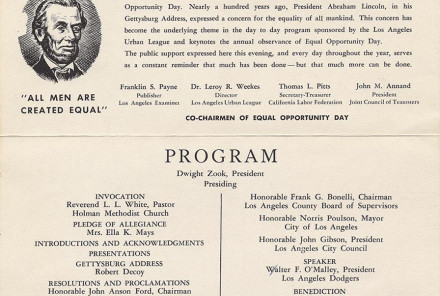
Dodger President Walter O’Malley is the featured speaker at Equal Opportunity Day, November 16, 1960, presented by the Los Angeles Urban League at the Statler Hilton Hotel in downtown Los Angeles.
The Dodgers created an opportunity for Don Newcombe to continue his baseball career. After his release from the Cleveland Indians in 1960, the Dodgers signed Newcombe to a minor league contract in 1961 Bill Nunn, Jr. Pittsburgh Courier, February 11, 1961 and this contract enabled Newcombe to extend his career with the Chunichi Dragons in Japan for the 1962 season. In 1970, Dodger President Peter O’Malley hired Newcombe as the first Director of Community Relations for a baseball team. Los Angeles Sentinel, May 21, 1970
Despite the end of segregation, baseball integration was still not complete. In 1961, a new battle would have to be fought with segregation in living quarters at baseball spring training sites in the South. Roy Campanella reflected on the issue in a 1964 book. Jackie Robinson, “Baseball Has Done It”, 1964 Only Dodgertown had integrated residences and dining room for spring training. National columnists noted the discrepancy and raised the issue and the Players’ Association conducted a survey. Bill Brower, American Negro Press, February 17, 1961 New York Times, February 19, 1961 Walter O’Malley, Correspondence to Robert Cannon, August 8, 1961 Open since 1948, Dodgertown was baseball’s only integrated base. One year later, seven clubs would join their players together for spring training and all clubs would be integrated by 1965.
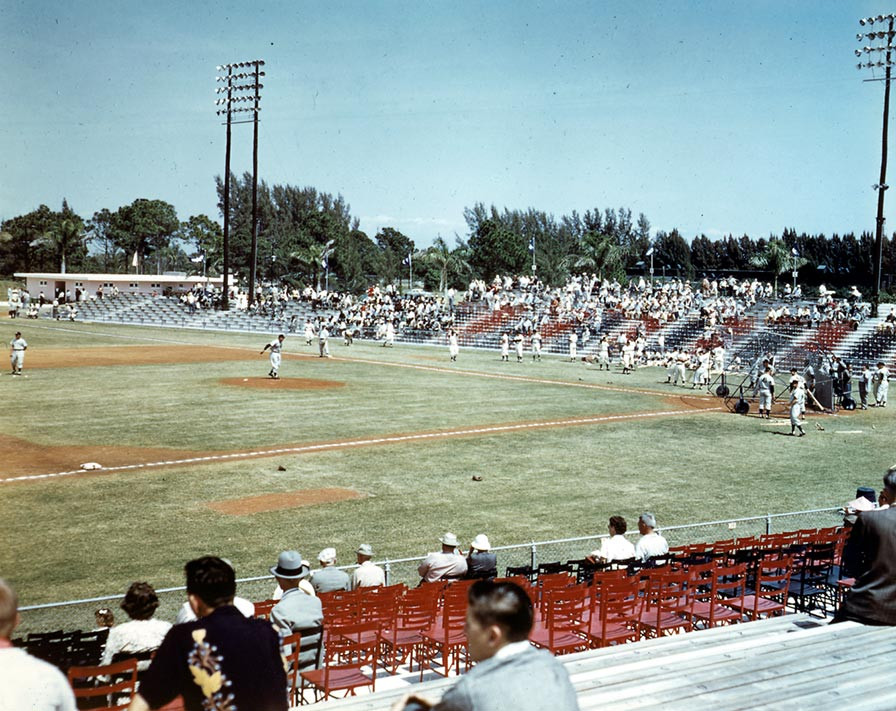
Batting practice at Holman Stadium in Dodgertown before an exhibition game. The individual chairs in the box seats were acquired from the Polo Grounds and Ebbets Field in New York.
Local segregation laws required separation in seating, drinking fountains, and restrooms in Holman Stadium at Dodgertown. In 1962, several Dodger players went to Peter O’Malley, the new Director of Dodgertown, and urged him to end all segregation and permit integrated seating, restrooms, and drinking fountains at Holman Stadium. After the players’ request, the Holman Stadium policy was changed overnight so anyone could sit anywhere in the ballpark. Ousie Shapiro and John Florio, “One Nation Under Baseball,” 2017 The segregated signs were painted over, abolishing “separate but equal” status. James Kirley, Indian River Press Journal, February 23, 1998 A Los Angeles columnist noticed the progress by the team and wrote, “In town, (Walter) O’Malley’s popularity hasn’t thickened.” Melvin Durslag, Los Angeles Herald-Examiner, April 11, 1962
The 1962 season was the inaugural season of Dodger Stadium, baseball’s finest park for its beauty and its comfort. Walter O’Malley entered the center field gates arm-in-arm with Jim Gilliam for an inaugural ceremony on April 9, 1962, the day before the opener on April 10, 1962. “From Digout to Dugout,” film, 1962
The 1963 World Championship season was as wonderful as could be. For the first time in team history, the Dodgers put a Black player, 1962 National League MVP Maury Wills, on the cover of their 1963 yearbook. The Dodgers regularly had five Black players in their starting lineup. When Willie Davis, Tommy Davis, Gilliam, Roseboro, and Wills were in the starting lineup, the Dodgers won 59 of 87 games for a winning percentage of .678, better than their overall team percentage of .611. And they capped their 1963 season, when for the first time in baseball history, five Black players, Davis, Davis, Gilliam, Roseboro, and Wills were on the Dodger Stadium field for the final out to win the World Series in the four-game sweep over the New York Yankees.
Dodger President Walter O’Malley took an interest in Los Angeles native and Pacific Coast League umpire Emmett Ashford. Legendary University of Southern California Head Baseball Coach Rod Dedeaux introduced O’Malley to Ashford. Dedeaux played two games at shortstop for the 1935 Dodgers.
O’Malley had heard all the great reports about Ashford’s umpiring work as a crew chief and, in 1963, at the request of Los Angeles Sentinel sports columnist L. I. “Brock” Brockenbury and Sentinel sports editor Brad Pye met with the trio at Dodger Stadium. The sports writers wanted to support and expedite his advancement. Ashford was a showman on the field who dressed immaculately with French cuffs, always hustled, and forcefully called each play. He loved the game of baseball. But no Black umpire had yet been hired to work in the major leagues.
O’Malley recognized how difficult a job an umpire has in baseball. It’s a lonely life of travel, moving from city to city after a series and working somewhat in isolation, plus jeering from partisan ballpark fans. Trying to become the first Black major league umpire was adding another layer of complexity. However, O’Malley kept encouraging Ashford to keep at it.
O’Malley would do what he always did – support anything that he felt was for the good of baseball. He talked to fellow baseball officials and worked behind the scenes to make it happen. After 12 years in the PCL, Ashford was hired by the American League to umpire starting on April 11, 1966, effectively breaking the racial barrier and opening the door for other Blacks to follow in the profession. Following his umpiring career, Ashford worked for Baseball Commissioner Bowie Kuhn as a traveling public relations adviser to help advance the game.
The 1964 season added a new generation of players. Willie Crawford of Fremont High in Los Angeles signed a bonus of $100,000, likely the highest amount ever paid to an amateur Black player. In the final weekend of the 1964 season, Gilliam received a standing ovation when it was announced in a Dodger Stadium game, he would be retained for 1965 as the first Black baseline coach in baseball history. Brock Brockenbury, Los Angeles Sentinel, October 4, 1964
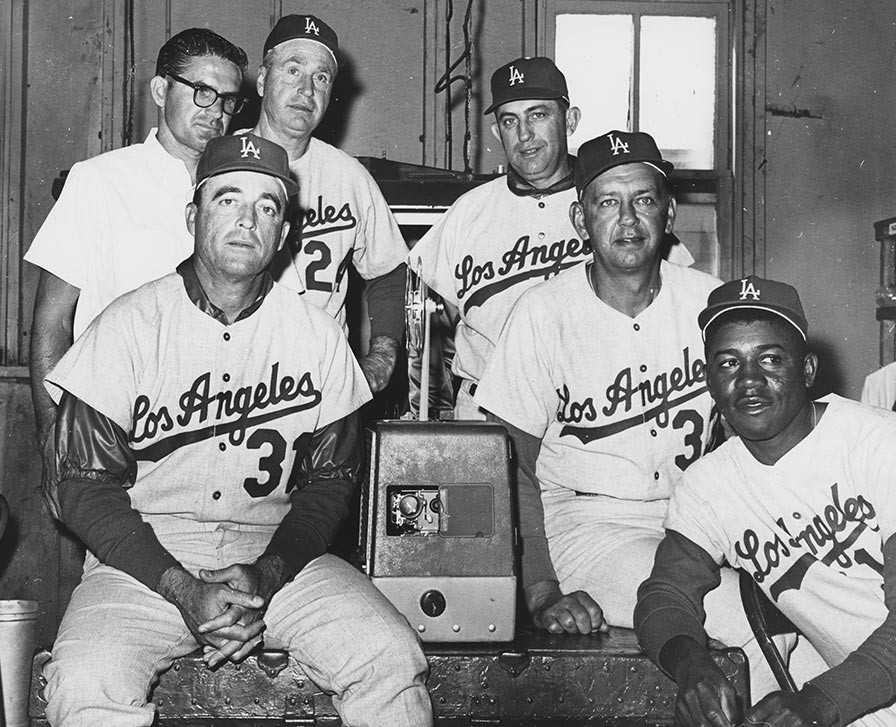
Clockwise: Harold “Lefty” Phillips, pitching coach; Danny Ozark, third base coach; Jim Gilliam, first base coach; Preston Gomez, assistant coach; Bill Buhler, trainer; Walter Alston, Dodger Manager. The 1965 Dodger coaching staff examines film at Dodgertown for their first season and is the first major league team to have two diverse members.
A new coaching staff in 1965 would accord the Dodgers’ another first. Along with Gilliam, Preston Gomez would be hired to coach third making the Dodgers the first team to have a Black baseline coach and a Cuban native baseline coach. The Dodgers would name Wills as their team captain, only the second Black in baseball history for that honor. Brad Pye, Jr., Los Angeles Sentinel, April 8, 1965 Wills once said he turned down other teams to sign with the Dodgers because, “He picked Brooklyn because of Jackie Robinson and other Negro players.” Wendell Smith, Pittsburgh Courier, June 18, 1966
The 1965 season was a Dodger World Championship, their fourth in the last 11 seasons. A critical move was to re-sign Gilliam as a player. He would make a game-saving defensive play in Game 7 of the 1965 World Series to help Koufax shutout Minnesota, 2-0. Lou Johnson, a non-roster player at the start of the season, was promoted to the Dodgers after outfielder injuries and tied for the team lead in home runs. His Game 7 home run in Minnesota provided the Dodgers’ first run to clinch the championship. Koufax said of Johnson’s 1965 season, “Lou Johnson’s the guy. If it had not been for the job he did, we might not be here today.” Ebony magazine, June, 1966
Jackie Robinson congratulated the Dodgers during their 1965 season. “Since taking on my assignment as a commentator on ABC-TV, I have tried to remain as objective as possible, but I must confess to being a Los Angeles Dodger rooter. I am proud of the performance of this team, which, at this time, stands first in the National League simply because it has that extra something its competitors in the league lack. Despite many problems and injuries to players, the Dodgers have displayed sheer doggedness and the ability to fight back. These qualities, I feel, justify labelling them one of the great teams of all times, win or lose… I believe it is a winning team because it is essentially a democratic one. In other areas of life, we can learn some great lessons from the Dodgers.” Jackie Robinson, Pittsburgh Courier, September 18, 1965

A postcard of the nine-hole golf course and wildlife sanctuary at Dodgertown in Vero Beach, Florida. Walter O’Malley had opened a makeshift pitch-and-putt course in 1954 and added a nine-hole golf course in 1965, so all players could enjoy a relaxing game as the two local existing golf courses were segregated.
The 1966 spring training season continued the integration progress at Dodgertown. Walter O’Malley approved, designed, and built a nine-hole, public golf course on Dodgertown property to provide recreation for all players as the two courses in town were privately owned. Los Angeles Sentinel, August 16, 1979 In a letter, O’Malley wrote, “You might be interested in the unpublished reason behind the golf course. First of all, it has little or no profit potential. In the spring our African American players were not invited to the private Riomar and Vero Beach Country Club courses…Rather than face an incident on this I decided to build nine holes which proved extremely popular with the players and incidentally, myself.” Walter O’Malley Correspondence, December 12, 1969 The green fees are a bargain at $3.00, enough to play all day. Miami Herald, April 1, 1966
In 1966, the Dodgers won their second consecutive NL Pennant, though they lost the World Series. The Dodgers would start six African American players 17 games in the 1966 season and win 10 of 17 games (.588 percentage). Their performance led a Pittsburgh columnist to write, “Over the years, millions of non-white fans have ‘adopted’ the Dodgers as their very own. They bet on them, cheer for them, with a continuously vigorous ardor.” Ric Roberts, Pittsburgh Courier, October 1, 1966
In a gracious move in 1967, the Dodgers signed 1955 World Series hero Sandy Amoros to a player’s contract. The outfielder needed seven days on a major league roster to qualify for a player’s lifetime pension. The Dodgers added Amoros to their active roster for sufficient days for him to qualify. Frank Finch, Los Angeles Times, May 6, 1967
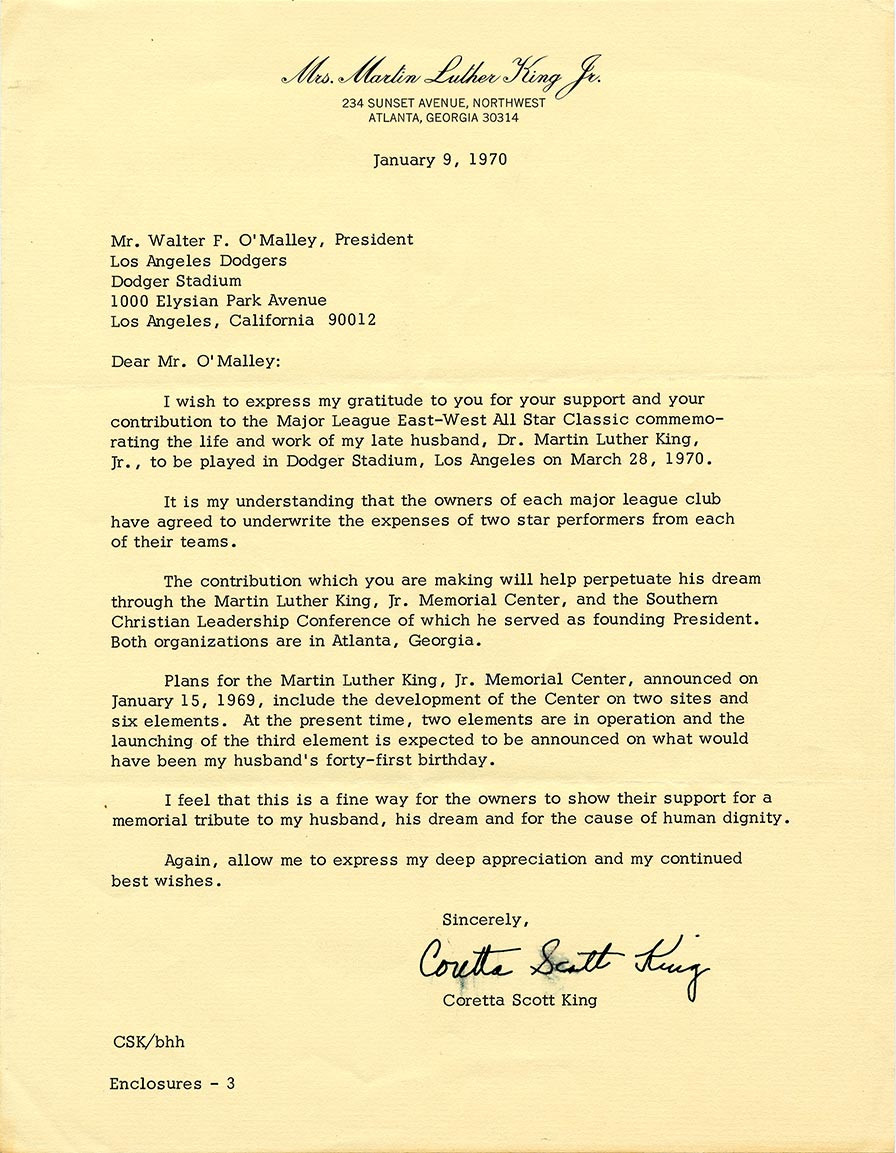
A January 17, 1970 letter from Coretta Scott King, widow of Martin Luther King, Jr., to Walter O’Malley expressing her appreciation to him for the Dodgers’ support and contributions to the Major League East West All-Star Classic. The exhibition game was played at Dodger Stadium on March 28, 1970 to raise funds for the Martin Luther King, Jr. Memorial Center in Atlanta.
The 1970s began a new decade and the Dodgers started with a new President, Peter O’Malley. Among his first decisions, Peter had agreed with the Southern Christian Leadership Conference to host a March 28, 1970 tribute game to Dr. Martin Luther King, Jr. at Dodger Stadium. Mrs. Coretta Scott King and former Dodger Jackie Robinson appeared. The number of star players was immense. Tom Verducci of Sports Illustrated wrote of 22 current and future Hall of Fame players participated in what the magazine called “The Greatest (Forgotten) Game Ever Played. Tom Verducci, Sports Illustrated, January 18, 2021 U.S. Senator John Tunney (D-California) entered information of the game into the Congressional Record. U.S. Senator John Tunney, Congressional Record, July 23, 1970
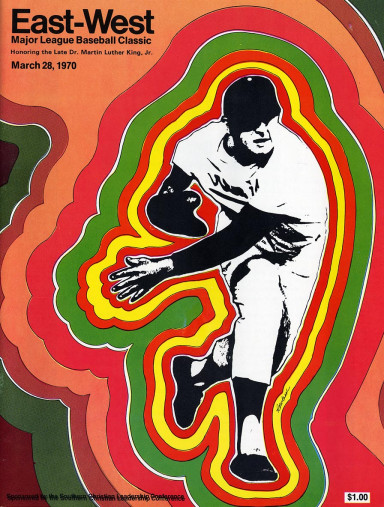
To honor Dr. Martin Luther King, Jr., an East-West Major League Baseball Classic benefit game was played on March 28, 1970 at Dodger Stadium.
The Dodgers would do more for the Los Angeles community and baseball. In 1970, former 1956 Cy Young Award and NL MVP Don Newcombe was hired as the team’s Community Relations Director, the first in the major leagues. Los Angeles Sentinel, May 21, 1970 Supporting his hope to one day manage a major league club, the Dodgers placed Maury Wills as manager of the Hermosillo team in the Mexican League during the winter of 1970, only the third African American to manage in the winter leagues. Wills would win a Mexican League championship his first season.
The Dodgers made baseball history on June 4, 1972, when they retired the uniform numbers of Roy Campanella (39); Sandy Koufax (32); and Jackie Robinson (42). This is the first time in baseball history an inactive Black player had their number retired (Active players Willie Mays had his No. 24 retired by the Giants and Frank Robinson had his No. 20 retired by the Orioles).
Robinson’s appreciation was immense. Sport’s greatest pioneer was genuinely touched by the honor. He told a sold out Dodger Stadium crowd, “This is truly one of the great moments in my life.” A.S. “Doc” Young, Pittsburgh Courier, June 24, 1972 In his 1972 autobiography, “I Never Had It Made,” Robinson stated, “The retirement of your number…well, that sort of caps the Hall of Fame honor.” Jackie Robinson, “I Never Had It Made,” 1972 Robinson met privately with Peter O’Malley during the weekend of his uniform retirement luncheon and pregame ceremony and a few days later would write O’Malley, “As I review the memorable events of last Sunday, I still question whether or not I was able to truly express my emotions to you and the fans. However, I want you to know that I was never so moved by the response of fans as on that day.” Jackie Robinson correspondence, June 8, 1972
Robinson’s final public appearance came October 15 before Game 2 of the 1972 World Series in Cincinnati, Ohio. Peter O’Malley had a significant influence on the Office of the Commissioner to honor Jackie at the Fall Classic. Kostya Kennedy, “True: The Four Seasons of Jackie Robinson,” 2022 O’Malley participated in a pregame tribute for Robinson. At that appearance, just nine days before his passing, Jackie spoke of his hope of a Black baseball manager in the major leagues.
The Dodgers knew of the great contributions Robinson made to the team and to baseball. The city of Pasadena honored Jackie and his 1932 Olympic silver medal winner brother Mack with a statue honoring the two brothers. Mack said of the required funding for the statues, “It was not easy to raise the money. Peter O’Malley and the Dodgers were very good. But a lot of baseball people weren’t.” Stan Isaac, Newsday, July 14, 1989 The team sponsored a plaque of number 42 at a park named for Jackie in Los Angeles. Brad Pye, Jr., Los Angeles Sentinel, November 22, 1973
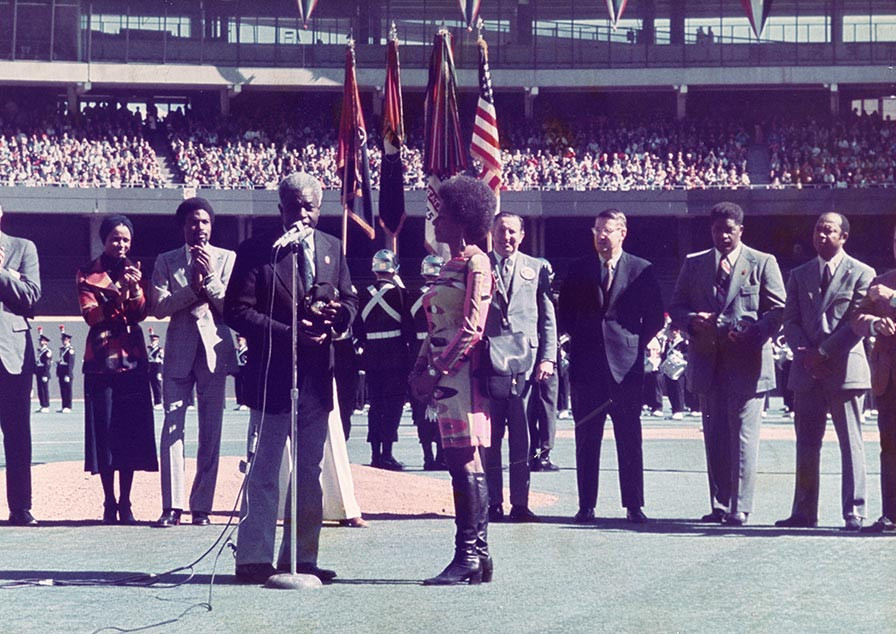
October 14, 1972, Riverfront Stadium, Cincinnati, Ohio. (L-R back row): Sharon Robinson, daughter of Jackie and Rachel; David Robinson, son of Jackie and Rachel; National League President Chub Feeney; Dodger President Peter O’Malley; former Dodger pitcher and teammate of Jackie, Joe Black; Monte Irvin, Commissioner’s Office. Robinson is at the microphone as he is honored before the start of Game 2 of the 1970 World Series. Standing with him is his wife, Rachel.
The next number to be retired by the Dodgers was to honor the great Jim Gilliam, who passed away shortly before the 1978 World Series. Gilliam is the only Dodger position player to play on four World Series championship teams in 1955, 1959, 1963, and 1965. His game-saving play in the seventh game of the 1965 World Series helped Sandy Koufax pitch the Dodgers to a World Championship. He was the first hitting coach in Dodger history Los Angeles Sentinel, February 10, 1977 and he instructed a new generation of Dodgers as Davey Lopes, Steve Garvey, Ron Cey, Dusty Baker, Bill Russell and other players on great Dodger teams in the 1970s.
The 1979 passing of Walter O’Malley led many to consider his impact on the game through his leadership. The Los Angeles Sentinel’s headline on the passing of Walter O’Malley was titled, “O’Malley Helped Blacks.” In the Sentinel’s article: “Walter O’Malley was a family man who dominated the game of baseball for thirty-five years and, along with Branch Rickey, gave black players their first real crack at the major leagues. Walter O’Malley will long be remembered by players of color for his very unique style of courage and for his warm humanity…He went to bat for black players back when it was unpopular, and he improved the game of baseball by his daring actions.” Los Angeles Sentinel, August 16, 1979 In his 1987 autobiography, former Dodger GM Buzzie Bavasi wrote, “Walter (O’Malley) had as much to do with Jackie’s (Robinson) reaching the big leagues as did Branch Rickey Buzzie Bavasi, “Off the Record”, 1986 and Bavasi also said, “Mr. Rickey selected the right player, but it was Walter (O’Malley) who opened the gates.” Milton Richman, United Press International, August 15, 1979 Roy Campanella said, “Definitely,” when asked of O’Malley’s contribution in the early stages of baseball integration. Joe McDonnell, Sepia magazine, September, 1980 From “Memories and Dreams,” the magazine of the National Baseball Hall of Fame, “We need to thank Dodgers’ owner Walter O’Malley for his open mindfulness. When you are next in Cooperstown, stop by his and Branch Rickey’s plaques and remember their brilliance in signing Robinson.” Jeff Idelson, “Memories and Dreams,” Spring, 2010
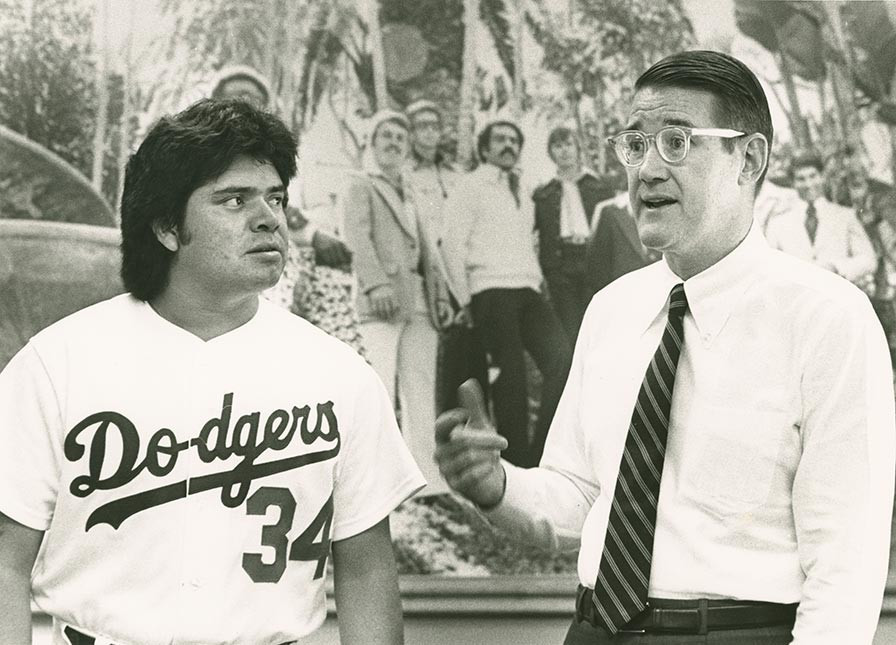
In May, 1981, Fernando Valenzuela, No. 34, is with Peter O’Malley, President, Los Angeles Dodgers. Fernando’s rookie season had just taken off and was the start of “Fernandomania” in the U.S. and his native Mexico. Fernando would win an important Game 3 of the 1981 World Series at Dodger Stadium when the Dodgers had a 2-0 deficit. The Dodgers would win the next three games to clinch the World Championship.
The 1980 season saw the debut of Fernando Valenzuela and the baseball world was entranced by his mastery. Mexico had long been a supplier of talent to the major leagues since 1930. However, from 1960 to 1979, only seven Mexican-born players had made their major league debut. Wikipedia, 2023 Peter O’Malley approved the 1979 acquisition of Valenzuela for an amount comparable to a first-round draft choice without ever seeing him pitch. Valenzuela’s 1981 season is memorable as the Dodgers won a World Championship through three post-seasons wins by No. 34. He would be elected the 1981 Cy Young Award and NL Rookie of the Year. After Valenzuela’s breakthrough, it became worth the effort for every team to scout, sign, and develop players from Mexico and the number of players from there grew steadily. O’Malley remembered the year of Fernando, known as “Fernandomania,” “as the most exciting time in the 28 or 29 years I was president of the ball club.” Joe Christiansen, Riverside Press Enterprise, May 27, 2001
The 1981 World Championship was won by the Dodgers over the New York Yankees in Yankee Stadium. Jackie Robinson’s wife Rachel, who was at Yankee Stadium on October 4, 1955, the day of the first World Championship, sat with Peter O’Malley and his wife Annette in his box when the Dodgers captured Game 6 over the New York Yankees and the 1981 World Championship. NBC Sports, October 28, 1981
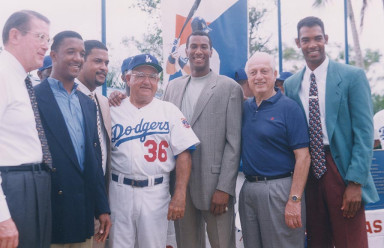
L-R: Peter O’Malley; Pedro Martinez; Raul Mondesi; Dodger Vice President, Campo Las Palmas Ralph Avila; Pedro Astacio; Tommy Lasorda; Ramon Martinez. Ceremony to celebrate famous alumni of Campo Las Palmas, February 7, 1998, at Campo Las Palmas, Guerra, Dominican Republic.
The Dodgers opened their signature Campo Las Palmas, Dominican Republic baseball academy in 1987, and their substantial investment in the country paid enormous dividends. Pedro Astacio, Pedro Martinez, Raul Mondesi, Adrian Beltre were scouted, signed and developed and the academy was regarded as the finest in baseball. One author wrote, “Throughout the island (Dominican Republic) it was known that the Dodgers cared more than other clubs; treated their charges better; and prepared them for their eventual journey to the U.S.” Ilan Stevens, “Beisbol,” 2012 Hall of Fame pitcher Juan Marichal, who retired from baseball as a Dodger said of Campo Las Palmas, “Look at this. There is nothing like it in all of the Caribbean…It’s awfully tough to compete with this.” Rob Ruck, “The Tropic of Baseball”, 1991
National League President A. Bartlett Giamatti was elected as Baseball Commissioner in 1988 and Bill White, former National League All-Star and baseball broadcaster was elected to replace him. Peter O’Malley chaired the search committee and convinced baseball owners to select White as National League President, the first African American to run a major sports league. A.S. “Doc” Young, Los Angeles Sentinel, July 13, 1989
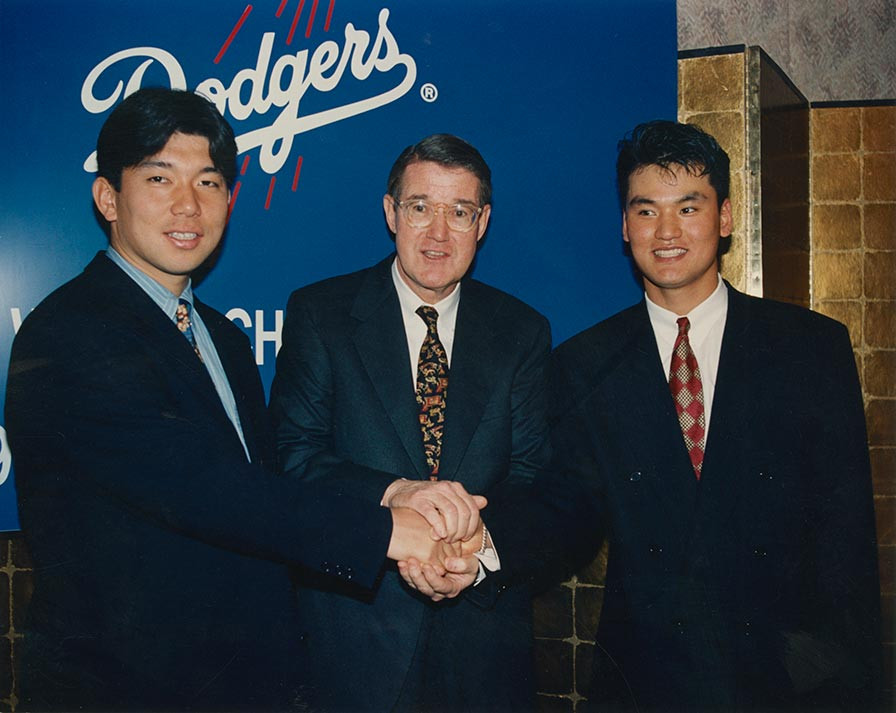
Dodger President Peter O’Malley greets two pioneer pitchers — Hideo Nomo (left) and Chan Ho Park (right) — at the press conference to introduce Japan-born Nomo to the Los Angeles media on February 13, 1995 at the New Otani Hotel in Little Tokyo, L.A. It wasn’t long before “Nomomania” took hold, exciting baseball fans from L.A. to Tokyo. Park is the first South Korea-born player in the majors and earned 124 wins, the most by any pitcher from Asia.
The decade of the 1990s had more breakthroughs, accomplished by the Dodgers. And Jackie Robinson was given credit. O’Malley said the international growth of baseball in other countries came from Robinson’s effort. “I think you’d have to consider that progress, bringing so many different cultures into baseball. You have to give Jackie credit for that, too.” Ray McNulty, Scripps-Howard News Service, April 16, 2012 Chan Ho Park of South Korea made his major league debut in 1994. By the end of the 2023 season, the impact of Park signing made South Korea a country to be regularly scouted by teams. An additional 26 South Korean-born players followed pioneer Park in making their major league debut. In 1995, Hideo Nomo signed as a free agent by the Dodgers and began the path for more Japan-born players to sign a major league contract. After Nomo made his debut in 1995, more than 65 Japan-born players to start the 2025 season have made it to the majors. Wikipedia, “Baseball Players From Japan,” October, 2023 Among those to enhance baseball talent were Ichiro Suzuki, a Baseball Hall of Famer in the U.S. and Japan, and later Shohei Ohtani.
Suzuki said his idea to play in the major leagues has to give regard to Hideo Nomo. “When I began, I never thought about it much. A really big influence was when (Hideo) Nomo signed a contract to play in the major leagues with the Dodgers. Up until then, it was merely an image in my mind, but when I saw Nomo play on television, the thought of playing in America became much clearer.” Jeff Idelson, “Memories and Dreams,” National Baseball Hall of Fame magazine, July/August 2006
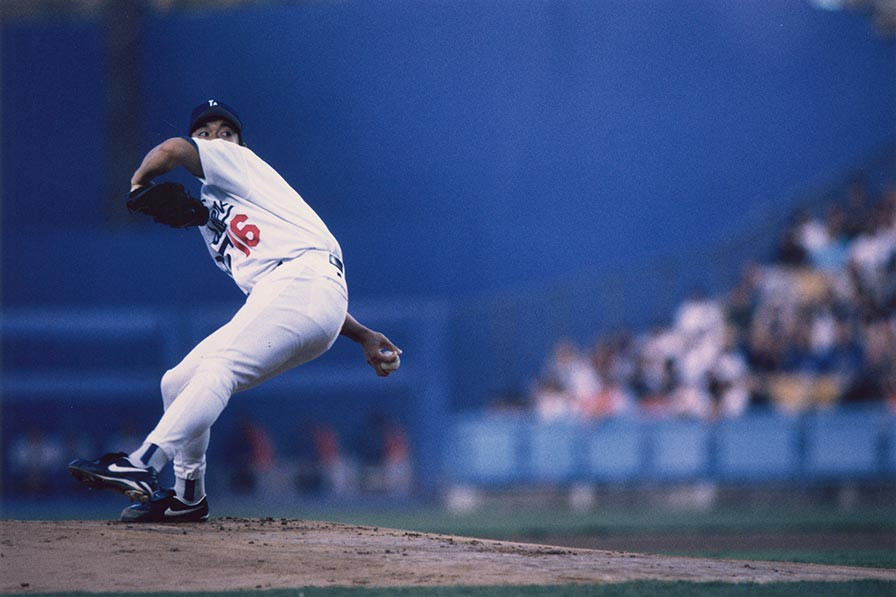
Hideo Nomo, No. 16, on the mound at Dodger Stadium. Known as the “Warrior,” Nomo had a twisting and turning delivery style that made it difficult for hitters to pick up the baseball. He was the first Japan-born player to make the major leagues in 30 years and he completed his career in America. A Hall of Famer in Japan, Nomo was named National League Rookie of the Year in 1995.
Ohtani, talked of being influenced by Japanese players, that included Hideo Nomo, in the major leagues: “Well, they are people who I really respect, and people whom I look up to as a player. I watched them on TV when I was little, wanting to become a player like them. The players whom I emulate and still aim to become.” Ben Verlander, “Searching for Shohei,” Jeff Snider, “Halos Today,” January 16, 2023
To honor the 50th anniversary of the major league debut of Jackie Robinson, the Dodgers paid tribute to the great player at Dodger Stadium on April 5, 1997. To introduce Rachel Robinson to the sellout crowd on that night, Peter O’Malley said, “Rachel, while we pay tribute to Jackie tonight, we also salute you, the greatest teammate Jackie ever had.” The Daily Breeze, April 5, 1997
Los Angeles youth baseball was expanded by the efforts of the team. The Dodgers invited the 1969 City (Los Angeles) High School Baseball Championship to be played at Dodger Stadium, a tradition that continues. The RBI (Reviving Baseball in the Inner Cities) program with strong support by the Dodgers, Ben Platt, MLB.com, February 25, 2008 played their championship game that was hosted at Dodger Stadium by the team. Eric Sondheimer, Los Angeles Times, May 27, 2018 With Dr. Creighton Hale at the helm as president and CEO, Little League Baseball entered the inner city of Los Angeles through the leadership provided by Peter O’Malley to build regulation diamonds. Brad Pye, Jr., New Pittsburgh Courier, April 13, 1996
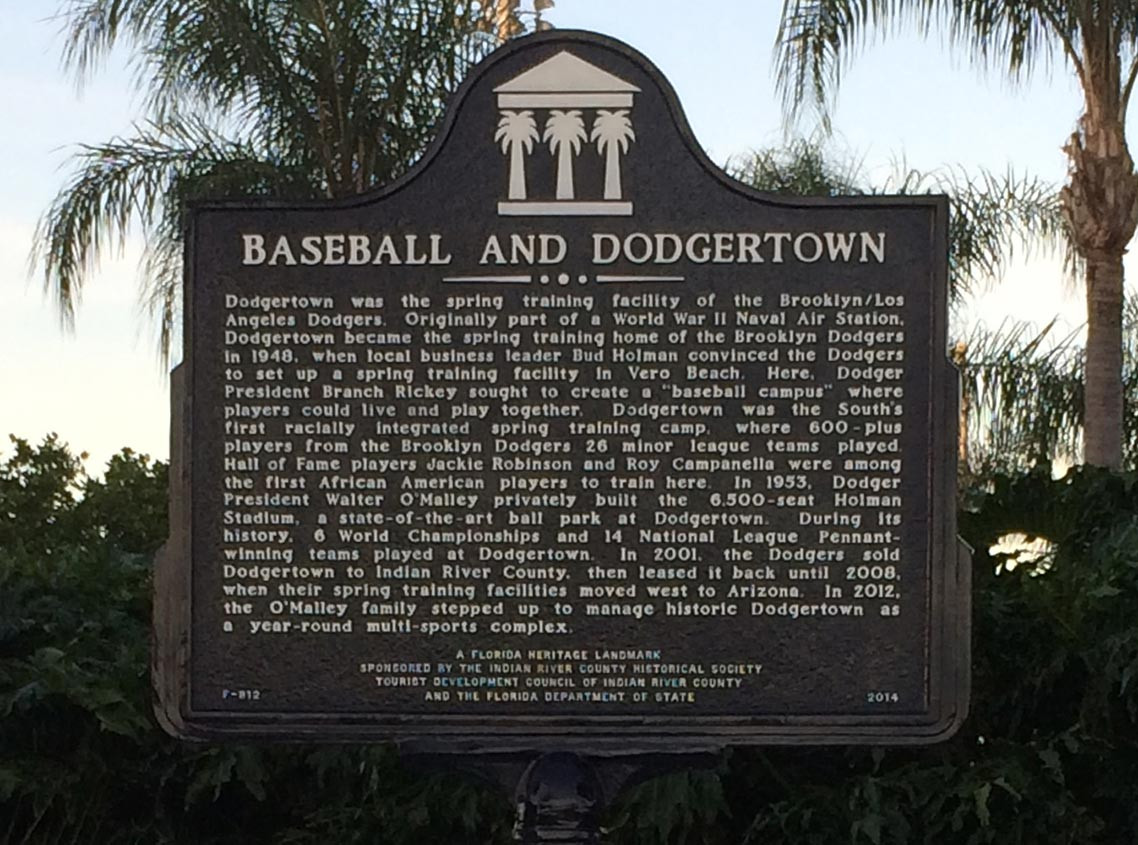
The historic marker “Baseball and Dodgertown” at Historic Dodgertown – Vero Beach, Florida, which makes the site a Florida Heritage Landmark, was unveiled on November 10, 2014. The ceremony was held during the 53rd Los Angeles Dodgers Adult Baseball Camp. The marker explains how Dodgertown was baseball’s first racially integrated Spring Training camp in the South.
Photo courtesy of Brent Shyer
The 21st century came into being. Through Peter O’Malley’s efforts, he assumed responsibility for the former Dodgertown spring training camp in Vero Beach, Florida and soon renamed it “Historic Dodgertown.” It was his hope to provide a new springboard for athletic development in multiple sports, but especially baseball. In 2014, to honor the debut of Jackie Robinson, he arranged for a regulation Florida State League game, a continued tradition by O’Malley, to be played at Historic Dodgertown, with proceeds benefiting United Way of Indian River County. A historical State of Florida marker was dedicated in November, 2014 Jessica Creagan, Hometown News, November 10, 2014 to honor baseball’s first integrated spring training camp in the South. Baseball Commissioner Rob Manfred approved the first Elite Development Invitational featuring young players by Major League Baseball to be played at Historic Dodgertown.
The Commissioner said, “We could have gone almost anywhere for this Elite Invitational, but we came to Dodgertown because we want to be a part of preserving it for future generations. Dodgertown was the gold standard for spring training facilities for a very long time.” Candace Moore, Treasure Coast Palm, July, 2016 He added, “Dodgertown was the original first-class spring training facility and one of the reasons we picked Dodgertown as the location for this invitational is that we think it’s worth preserving. And using it for events like this is important for preserving it.” TC Palm, July 28, 2016 Dividends from the first camp were paid quickly as Hunter Greene, the second overall pick in the June, 2017 Free Agent Draft, played in the first Invitational.
In 2019, Historic Dodgertown was added to the U.S. Civil Rights Trail, locations that are significant to the recognition of American civil rights. On the U.S. Civil Rights Trail website, they write of Dodgertown, “These progressive actions that began with a baseball team went beyond Dodgertown and Vero Beach, influencing social change nationwide.” U.S. Civil Rights Trail website, “Vero Beach” It is the only sports site so honored.
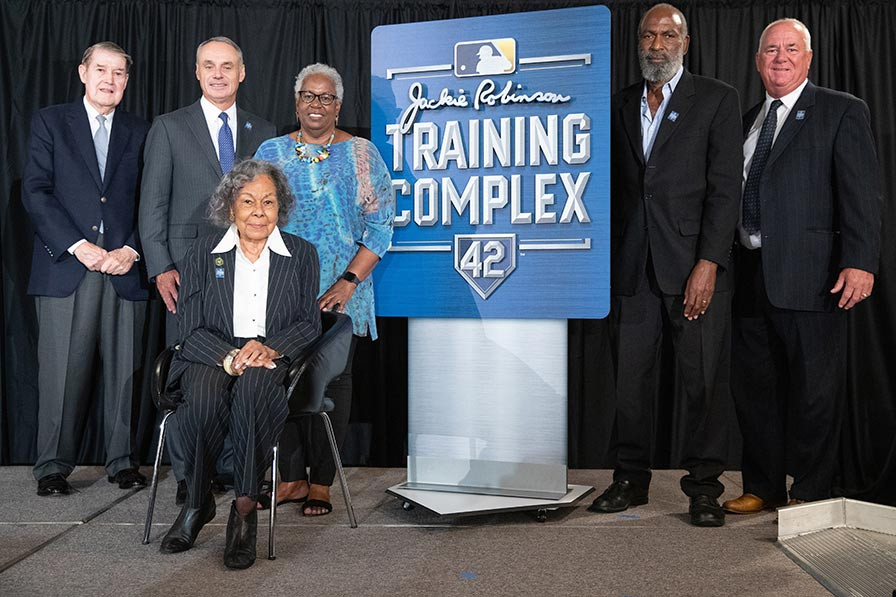
April 2, 2019, Vero Beach, Florida (L-R) Peter O’Malley; Baseball Commissioner Robert D Manfred Jr.; Sharon Robinson; Rachel Robinson (seated); David Robinson; and Indian River County Commissioner Peter O’Bryan unveil the new name of the Jackie Robinson Training Complex at the former Historic Dodgertown during a press conference.
Photo by Steven Martine/MLB Photos via Getty Images
MLB recognized O’Malley’s efforts and contribution for continued baseball development and in 2019, they assumed business operations and re-named Historic Dodgertown, the “Jackie Robinson Training Complex.” The Baseball Commissioner was present for the dedication and special guests that day included Rachel Robinson, widow of Jackie, daughter Sharon and son David.
The Dodger efforts regarding baseball integration are unparalleled. One author wrote, “The dominant truth of the Jackie Robinson Dodgers was integration. They were the first integrated major league baseball team and so the most consciously integrated team and, perhaps, the most intensely integrated team…the dozen or so athletes who were at the core of the team, and are at the core of this book, stood together in purpose and for the most part in camaraderie. They respected one another as competitors, and they knew that they were set apart.” Roger Kahn, “The Boys of Summer,” 1971 Street and Smith’s Sports Business Journal named the Dodgers the “Best Major League Baseball Franchise of the 20th Century”. walteromalley.com
Compliments to the team come from every corner. “The Dodgers had become the gold standard for baseball organizations and would remain so for many years. They had a brilliant owner, excellent executives and managers throughout the system, great scouts, and a productive player-development system.” Mark Armour and Daniel R. Levitt, “In Pursuit of Pennants,” 2015
And maybe, everything can be summed up from this in the New York Times by Kurt Streeter on the Dodger visit to the White House, “The Dodgers are not just any club. In the last century, they stood at the vanguard of civil rights in sports. Mythology developed around them, passed down through decades of consistency: The Dodger Way, which means not just winning, but winning with class.” Kurt Streeter, New York Times, August 23, 2021

